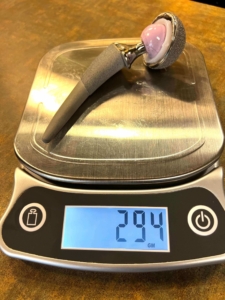Many patients step on their bathroom scales after hip replacement to find that they have put on up to 10-15 pounds overnight. If this is you, don’t panic! It’s just fluid weight, and it’s temporary.
Surgery is stressful for your body. It’s response is to move a significant amount of fluid from your blood vessels to the space between the blood vessels and your cells.
That’s why on the day of surgery, we will give you a LOT of IV fluids to maintain your blood pressure – to compensate for the fluid that will leave your bloodstream and move to your tissues. We typically give you saline as soon as you arrive on the day of your surgery, and we’ll also continue to give your fluids during the operation itself. In fact, you might get as much as 3 liters of fluid that day. And that amount of liquid weighs around 10lb.
FLUID ACCUMULATION WILL CONTINUE FOR SEVERAL DAYS AFTER SURGERY
You’ll probably also find that in the first 24 hours or so – you feel more thirsty than usual. You will also most likely find that you are consuming more than you are losing. In the old days, we used to track what we called ins and outs – the fluid that patients were drinking and how much urine they were producing – to check the fluid balance at the end of the day. What we’d typically find is that in the first few days post-surgery – that’s the inflammatory phase–people are generally taking in more fluids than they are getting rid of.
You might notice that this changes at around day 3- 5 after surgery. This is when your urine output significantly increases even if you are not taking in more fluids. If you have any pre-existing urinary issues, for example, pelvic floor dysfunction, this is when you are going to notice them as your body works overtime to restore its normal fluid balance.
The good news is that when your fluid balance returns to normal, all these issues also return to normal.
HOW MUCH DO HIP REPLACEMENT IMPLANTS WEIGH?
The implants we use in most cases are typically made of titanium, with a ceramic head and a polyethylene liner. Their combined weight is very close to the weight of the bone removed. This example weighs just under 300g – that’s just over 10oz.









